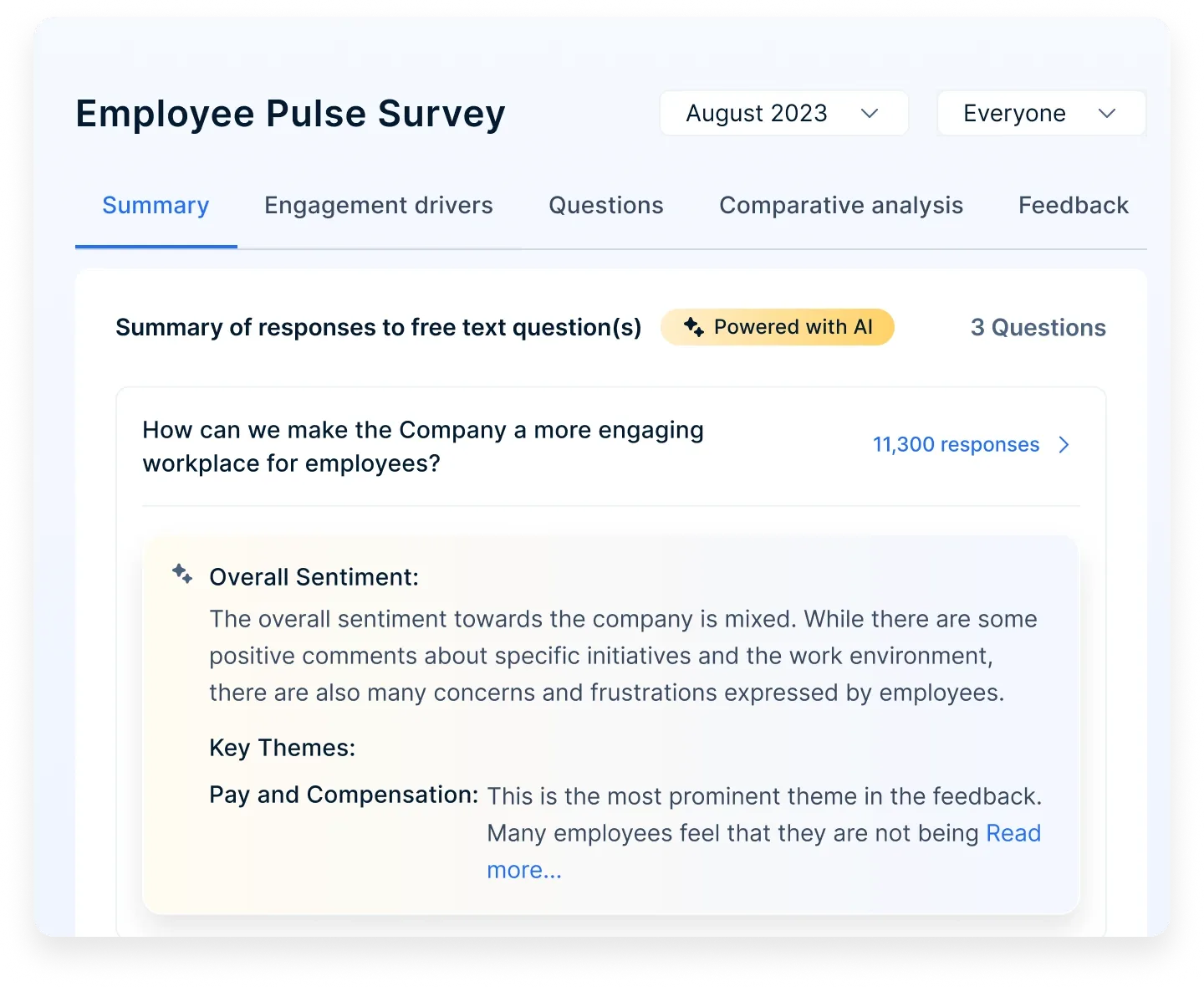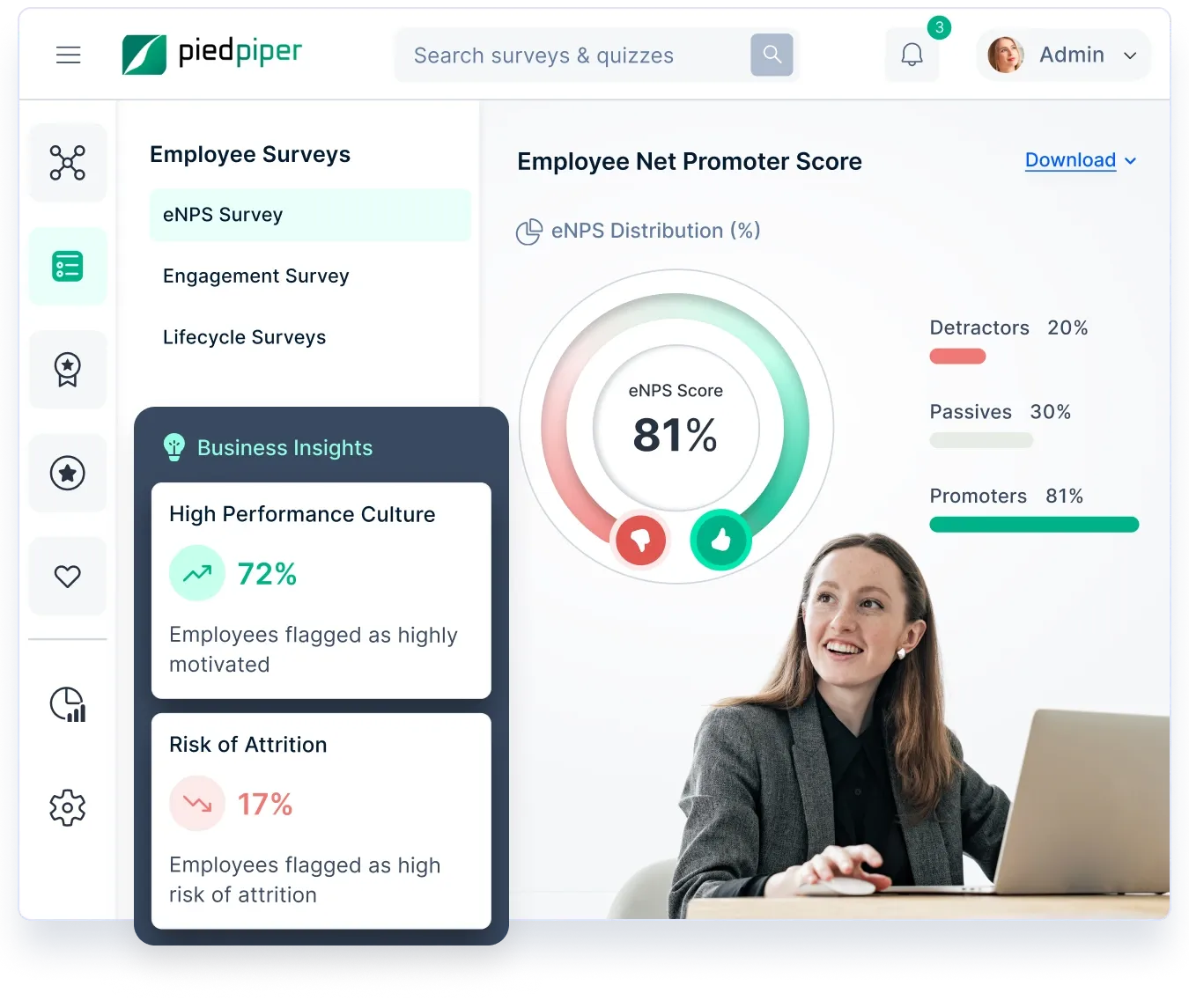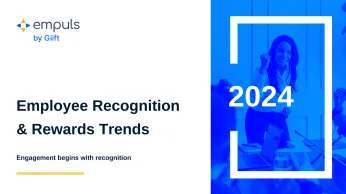صافي نقاط المروجين للموظفين: الدليل إلى ماذا ولماذا وكيف في نظام eNPS
يُعد صافي نقاط المروجين للموظفين (eNPS) مقياسًا بسيطًا ولكنه قوي لقياس رضا الموظفين ومشاركتهم. في هذا الدليل، نستكشف كيفية عمل eNPS وفوائده وكيف يمكن للشركات الاستفادة منه لخلق قوة عاملة أكثر تفاعلاً.
في هذه الصفحة
- Understanding employee net promoter score (eNPS)
- Benefits of employee net promoter score (eNPS)
- لماذا يجب على المنظمات الانتباه إلى eNPS؟
- How to calculate and implement the net promoter score for employee engagement?
- تحليل نتائج استبيان صافي نقاط المروجين للموظفين لتحسين المشاركة
- Acting on the eNPS results to improve employee engagement
- Empuls eNPS Surveys: Measure and improve employee loyalty with precision
- استنتاج
- الأسئلة الشائعة
“To win in the marketplace, you must first win in the workplace,” said Doug Conant, CEO of Campbell’s Soup.
إن وجهة نظر دوغ كونانت ليست حالة معزولة بالنسبة للعديد من المديرين والرؤساء التنفيذيين الناجحين الذين يفهمون قيمة الاستثمار في موظفيهم.
A company’s success isn’t just about products or profits—it starts with the people behind them. Engaged employees drive innovation, strengthen customer relationships, and fuel long-term growth. But how do you measure engagement beyond assumptions and gut feelings? This is where the Employee Net Promoter Score (eNPS) comes in.
Originally designed to track customer loyalty, Net Promoter Score for employee engagement has evolved into a crucial metric for understanding workplace satisfaction. Companies that actively monitor and improve their employee NPS see tangible benefits—higher retention, increased productivity, and a more committed workforce. Studies show that organizations with engaged employees experience 27% higher profits, 50% better customer loyalty, and a 15% drop in turnover.
By leveraging employee NPS, businesses gain valuable insights into what motivates their teams, allowing them to make informed decisions that foster a positive work environment. A strong eNPS isn’t just a number—it’s a reflection of a workplace where employees feel valued and empowered. In this guide, we’ll break down how to use Net Promoter Score for employee engagement to build a happier, more loyal workforce.
Understanding employee net promoter score (eNPS)
Employee Net Promoter Score (eNPS) is an adaptation of the traditional Net Promoter Score (NPS) used to measure employee loyalty and satisfaction. eNPS involves asking employees a simple question:
"On a scale of 0 to 10, how likely are you to recommend our company as a place to work to a friend or colleague?"
Responses are categorized into three groups:
- Promoters (9-10),
- Passives (7-8), and
- Detractors (0-6).
المروجون هم المؤيدون المتحمسون الذين من المرجح أن يوصوا بالشركة. أما السلبيون فهم الموظفون الراضون ولكن غير المتحمسين الذين هم عرضة للعروض المقدمة من المنافسين. المنتقدون هم الموظفون غير الراضين الذين قد يؤثرون سلبًا على الآخرين ويضرون بسمعة الشركة.
إن بساطة ووضوح نظام eNPS يجعل منه أداة قيّمة لقياس المشاركة. فهو يوفر لمحة واضحة عن مشاعر الموظفين، مما يسمح للشركات بتحديد المجالات التي تحتاج إلى تحسين بسرعة. من خلال قياس eNPS بانتظام، يمكن للمؤسسات تتبع التغيرات في مشاركة الموظفين بمرور الوقت وتقييم تأثير مبادراتها التي تهدف إلى تحسين بيئة العمل.
Benefits of employee net promoter score (eNPS)
Tracking employee sentiment isn’t just about keeping your workforce happy—it directly impacts business performance. Employee net promoter score (eNPS) helps organizations measure engagement, improve retention, and create a thriving work culture. Here’s how this simple yet powerful metric can benefit your business.
1. Clear measurement of employee engagement
Many companies struggle to gauge how engaged their workforce truly is. Employee NPS simplifies this by providing a straightforward metric that measures employee sentiment. A high eNPS indicates a motivated and satisfied workforce, while a low score highlights areas that need improvement.
2. Improved employee retention
A strong employee NPS signals a positive work environment where employees feel valued and heard. Organizations that track and act on eNPS insights experience lower turnover rates, reducing hiring costs and maintaining a stable, experienced workforce.
3. Higher productivity and performance
Engaged employees contribute more, work efficiently, and are more committed to business goals. Studies show that companies with higher net promoter score for employee engagement experience increased productivity, leading to better customer satisfaction and higher revenue.
4. Data-driven decision making
Instead of relying on assumptions, eNPS provides actionable insights that help HR teams and leadership make informed decisions. By analyzing eNPS trends, companies can implement strategies that enhance workplace culture, benefits, and management practices.
5. Stronger employer brand
A high eNPS means employees are more likely to recommend the company as a great place to work. This strengthens the company’s reputation, making it easier to attract top talent and position itself as an employer of choice in a competitive job market.
Using employee net promoter score as a continuous feedback loop helps businesses create an employee-first culture. When employees feel valued, they stay longer, perform better, and contribute to a workplace that thrives.
لماذا يجب على المنظمات الانتباه إلى eNPS؟
eNPS ليس مجرد طفل جديد على الكتلة عندما يتعلق الأمر بالمقاييس. لقد قدمت نتائج تم اختبارها عبر الزمن وثبتها. لهذا السبب ، تبنت بعض أفضل الشركات في جميع أنحاء العالم eNPS كجزء من برامج التفاعل بين الموظف وصاحب العمل.
يتجاهل العديد من المتشككين فوائد صافي نقاط الترويج للموظفين وحقيقة أنه في حين أن eNPS وحدها قد لا تكون قادرة على المساعدة في زيادة مستويات مشاركة الموظفين ، فإن مجرد حقيقة أن المؤسسة تجري استطلاعا منتظما ل eNPS يثبت شعورا إيجابيا بأن الإدارة تستمع وترغب في التصرف بناء على ملاحظات الموظفين.
هذا التصور وحده يمكن أن يزرع بذور ضمان مستويات مشاركة الموظفين فوق المستوى ، كما شوهد في قصص النجاح المختلفة.
1. أدوبي
أدوبيوهي شركة رائدة في مجال البرمجيات، أدركت أن الحفاظ على مستويات عالية من مشاركة الموظفين أمر بالغ الأهمية لاستمرار الابتكار والنجاح. ومع ذلك، واجهت الشركة تحديات مع تفاوت مستويات المشاركة بين مختلف الفرق والأقسام.
تطبيق eNPS: أدخلت Adobe نظام eNPS كجزء من استراتيجية مشاركة الموظفين لجمع تعليقات منتظمة. وقد أجرت الشركة استطلاعات ربع سنوية لاستطلاع رأي الموظفين حول eNPS لتتبع مشاعر الموظفين وتحديد مجالات التحسين.
الإجراءات المتخذة: كشفت التعليقات أن الموظفين يرغبون في الحصول على المزيد من فرص التطوير الوظيفي والتواصل الشفاف من القيادة. واستجابة لذلك، أطلقت أدوبي عدة مبادرات، بما في ذلك:
- برنامج شامل للتطوير الوظيفي مع مسارات تعليمية مخصصة وفرص إرشادية.
- لقاءات مفتوحة منتظمة وقنوات تواصل شفافة يتبادل فيها القادة آخر المستجدات ويعالجون مخاوف الموظفين.
النتائج: بمرور الوقت، شهدت Adobe تحسناً ملحوظاً في نتائج eNPS. أفاد الموظفون بأنهم يشعرون بمزيد من التقدير والدعم، مما أدى إلى ارتفاع مستويات المشاركة. كما لاحظت الشركة أيضاً تأثيراً إيجابياً على الإنتاجية والابتكار، حيث أصبح الموظفون أكثر تحفيزاً للمساهمة في نجاح Adobe.
2. بين وشركاه
شركة Bain & Companyوهي شركة استشارات إدارية عالمية، أرادت التأكد من أن مستشاريها، الذين غالباً ما يعملون في بيئات شديدة التوتر، يشعرون بالتفاعل والدعم.
تطبيق نظام eNPS: أدخلت شركة Bain نظام eNPS لقياس شعور الموظفين بانتظام وتحديد المجالات التي تحتاج إلى اهتمام.
الإجراءات المتخذة: أشارت الملاحظات إلى الحاجة إلى تحقيق توازن أفضل بين العمل والحياة الخاصة والمزيد من فرص التطوير المهني. استجابت شركة باين من خلال تنفيذ جداول عمل مرنة، وتعزيز التوازن بين العمل والحياة الشخصية، وتوسيع برامج التطوير المهني، بما في ذلك المزيد من الدورات التدريبية وفرص النمو الوظيفي.
النتائج: شهدت شركة Bain تحسناً ملحوظاً في نتائج eNPS. فقد شعر الموظفون بمزيد من التوازن وأعربوا عن تقديرهم لاستثمار الشركة في نموهم المهني. وأدى ذلك إلى ارتفاع مستويات الرضا الوظيفي والاحتفاظ بهم.
3. التفاح
احتاجت شركة Apple، بشبكتها الواسعة التي تضم أكثر من 500 متجر للبيع بالتجزئة، إلى طريقة للحفاظ على مستويات عالية من مشاركة الموظفين والابتكار في قوتها العاملة المتنوعة.
تطبيق eNPS: قامت شركة Apple بتكييف نظام صافي المروجين ® Net Promoter System، المستخدم تقليديًا لقياس ولاء العملاء، لإشراك موظفيها. وقد صاغت الشركة مصطلح "صافي المروجين للأشخاص" للتعبير عن هذا النهج الجديد.
الإجراءات المتخذة: باستخدام مبادئ نظام صافي المروجين (Net Promoter System)، مكّنت شركة Apple الموظفين من المساهمة بأفكارهم وملاحظاتهم، مما أدى إلى العديد من الابتكارات المميزة في المتجر. شجع هذا النهج الموظفين على إضفاء الطاقة والحماس والإبداع على أدوارهم.
Results: The implementation of Net Promoter for People contributed to Apple's retail success. Many innovations in Apple's stores, such as the Genius Bar and the Today at Apple program, emerged from employee suggestions. This empowerment led to a more engaged workforce, which in turn enhanced the customer experience.
من خلال الاستفادة من نظام صافي المروجين للأفراد، خلقت Apple ثقافة يشعر فيها الموظفون بالتقدير والإلهام. ولم يؤد ذلك إلى تحسين رضا الموظفين فحسب، بل تُرجم أيضًا إلى خدمة عملاء أفضل، وولاء أعلى للعملاء، وزيادة المبيعات. يُظهر نجاح هذا النهج في شركة Apple التأثير القوي لاستخدام نظام eNPS لتعزيز بيئة عمل جذابة ومبتكرة.
4. مايكروسوفت
مايكروسوفتوهي شركة تكنولوجيا عالمية عملاقة، واجهت تحديات في الحفاظ على مستويات عالية من مشاركة الموظفين عبر قوتها العاملة الواسعة والمتنوعة. وأدت الوتيرة السريعة للتغيير والابتكار في بعض الأحيان إلى شعور الموظفين بالانفصال والإرهاق.
eNPS implementation: Microsoft implemented eNPS to regularly gauge employee sentiment and identify areas needing improvement. They conducted eNPS surveys bi-annually to track engagement levels and gather actionable feedback.
الإجراءات المتخذة: سلطت التعليقات الضوء على الحاجة إلى تحقيق توازن أفضل بين العمل والحياة الشخصية والمزيد من الفرص للنمو الشخصي والمهني. واستجابة لذلك، قدمت مايكروسوفت عدة مبادرات:
- تعزيز المرونة في ترتيبات العمل، بما في ذلك خيارات العمل عن بُعد وساعات العمل المرنة.
- توسيع نطاق برامج التعلم والتطوير، وتقديم مجموعة متنوعة من الدورات والموارد لتنمية المهارات.
- زيادة التركيز على رفاهية الموظفين من خلال برامج العافية ودعم الصحة النفسية.
النتائج: أدت هذه الإجراءات إلى تحسن ملحوظ في درجات eNPS. وأفاد الموظفون بأنهم يشعرون بمزيد من التوازن والدعم والتقدير. وقد تُرجم هذا التحول الإيجابي في المشاركة إلى زيادة الإنتاجية والابتكار والرضا الوظيفي بشكل عام.
5. ANCA Machine Tools
ANCA Machine Tools أدركت الحاجة إلى نظام مكافآت أكثر شفافية واتساقاً لتعزيز مشاركة الموظفين. فقد كان نهجها الحالي غير منتظم، مما أدى إلى فك الارتباط بين الموظفين. ولمعالجة هذه المشكلة، قررت شركة ANCA قياس رضا الموظفين وتحسين المشاركة باستخدام نظام eNPS كجزء من استراتيجيتها الأوسع نطاقاً لتقدير الموظفين.
eNPS implementation: ANCA Machine Tools integrated Empuls to not only automate their rewards system but also to gather valuable employee feedback through eNPS surveys. The platform enabled them to track employee satisfaction and gauge how likely employees were to recommend the company as a great place to work. These regular surveys provided insights into areas of improvement and helped shape their engagement strategies.
الإجراءات المتخذة:
- تم إطلاق استبيانات eNPS عبر الموقع الإلكتروني Empuls لرصد رضا الموظفين وتتبع المشاركة مع مرور الوقت.
- إجراء استطلاعات منتظمة لمشاركة الموظفين لقياس فعالية برنامج المكافآت وبيئة العمل بشكل عام.
- الاستفادة من التعليقات الواردة من نتائج eNPS لتعديل برنامج التقدير ومعالجة مخاوف الموظفين المحددة.
- تبسيط عملية الترشيح والمكافآت، مما يضمن تقدير الموظفين باستمرار بناءً على الملاحظات الواردة.
النتائج: بعد تنفيذ استبيانات نظام eNPS، شهدت شركة ANCA Machine Tools أن 80% من الموظفين سجلوا أنفسهم كـ "مروجين"، مما يشير إلى مستويات رضا عالية. بالإضافة إلى ذلك، كانت هناك زيادة بنسبة 100% في درجات مشاركة الموظفين، مما يعكس التأثير الإيجابي لنظام المكافآت المتكرر والشفاف. وقد ساعد الاستخدام المنتظم لنظام eNPS شركة ANCA على تحسين مبادرات مشاركة الموظفين بشكل مستمر وتعزيز العلاقة بين القوى العاملة والشركة.
6. تليد الخليج
تليد الخليجوهي مؤسسة رائدة في المملكة العربية السعودية، تهدف إلى تعزيز مشاركة الموظفين والاحتفاظ بهم من خلال مواءمة القوى العاملة لديها مع القيم الأساسية للشركة. ولقياس مدى رضا الموظفين وتعزيزه، احتاجت الشركة إلى طريقة متسقة وغير متحيزة لجمع الملاحظات وتتبع المشاركة في جميع أنحاء الشركة.
تطبيق eNPS: قدمت شركة جلف تاليد Empuls كمنصة متكاملة لمشاركة الموظفين، مع التركيز على استخدام استبيانات eNPS واستبيانات المشاركة لقياس أثر التقدير والتقييم وشعور الموظفين بشكل عام. قدمت هذه الاستطلاعات رؤى قيمة حول رضا الموظفين وساعدت في تحديد مجالات التحسين.
الإجراءات المتخذة:
- إطلاق استبيانات eNPS عبر الموقع الإلكتروني Empuls لقياس مستويات رضا الموظفين ومشاركتهم بانتظام.
- تنفيذ استطلاعات رأي للملتحقين الجدد لالتقاط وجهات نظر جديدة حول ثقافة الشركة وعملية التأهيل.
- دمج نتائج الاستبيان في استراتيجية التقدير الخاصة بالشركة لمواءمة التقدير مع ملاحظات الموظفين بشكل أفضل.
- استخدم Empuls لتتبع وتحليل استجابات eNPS، وتحديد أنماط رضا الموظفين والمجالات التي تتطلب الاهتمام.
النتائج: من خلال منصة Empuls ، حققت شركة جلف تليد معدل إكمال 70% من استبيانات eNPS الخاصة بهم في غضون سبعة أيام. وقد ساعدت الرؤى التي تم جمعها في تشكيل استراتيجية مشاركة الموظفين، حيث تم تسجيل أكثر من 300 حالة تقدير من الأقران في ستة أشهر فقط. بالإضافة إلى ذلك، شهدت الشركة تحسناً ملحوظاً في الاحتفاظ بالموظفين والروح المعنوية والتوافق مع قيم الشركة.
يقدم العمال السعداء والملتزمين خارطة طريق محددة للمؤسسات الناجحة. توفر نقاط الترويج الصافية لمشاركة الموظفين طريقة سهلة وملموسة للتأكد من مستويات مشاركة الموظفين ، مما يساعد الشركات على الحفاظ على بيئة عمل جذابة للغاية تفيد كل من الموظفين والإدارة.
How to calculate and implement the net promoter score for employee engagement?
Measuring and improving employee engagement starts with understanding how employees feel about the workplace. Employee net promoter score (eNPS) provides a simple yet effective way to gauge sentiment, track trends, and take action. Here’s how to calculate and implement eNPS to create a more engaged workforce.
Calculating eNPS for employee engagement
Employee net promoter score (eNPS) is calculated using a straightforward formula. Once employees respond to the question, "How likely are you to recommend our company as a place to work to a friend or colleague?", their answers are categorized into promoters (9-10), passives (7-8), and detractors (0-6). The final eNPS score is derived by subtracting the percentage of detractors from the percentage of promoters, while passives are excluded from the calculation.
Since eNPS results can vary based on when and how the question is asked, companies adopt different approaches, gathering feedback monthly, quarterly, or annually to track trends effectively. The scoring scale ranges from -100 to 100, with scores above 50 considered excellent, 10 to 30 as good, and anything below zero signaling the need for immediate action.
While eNPS is a valuable metric for measuring employee sentiment, it shouldn’t be viewed in isolation. Comparing results over time provides a clearer picture of engagement trends and allows businesses to adjust strategies accordingly. Regular assessments, ideally conducted every quarter, help organizations keep a pulse on employee satisfaction and address issues proactively.
Implementing eNPS for employee engagement
Implementing eNPS requires a structured approach to ensure accurate insights and meaningful action. Here’s how companies can effectively roll out an eNPS survey.
1. Designing the survey
The core eNPS question should be simple and direct: “How likely are you to recommend our company as a workplace to a friend or colleague?” To gather deeper insights, follow up with open-ended questions like “What is the primary reason for your score?” or “What improvements would enhance your experience?”
2. Selecting the right questions
To make eNPS more actionable, questions should be easy to understand and focused on key engagement drivers such as job satisfaction, work environment, leadership, and career growth opportunities.
3. Choosing the right survey frequency
To track engagement effectively, eNPS surveys should be conducted at regular intervals—quarterly or bi-annually—to monitor trends while avoiding survey fatigue. Too frequent surveys can lead to lower participation and less honest responses.
4. Encouraging honest and constructive feedback
Anonymity is key to getting candid responses. Employees should be assured that their feedback is confidential and used for workplace improvements. Clearly communicating the purpose of the survey fosters transparency and trust.
5. Analyzing eNPS results
Once the eNPS is calculated, companies must go beyond the score and analyze patterns in responses. Breaking down data by departments, job levels, or demographics can uncover specific issues that require attention.
6. Acting on feedback and driving change
eNPS is only valuable if organizations act on it. HR and leadership teams should develop action plans to address key concerns raised in the survey. Sharing updates on the improvements being made helps reinforce trust and shows employees that their voices matter. Regular follow-ups and adjustments based on ongoing feedback ensure continuous engagement enhancement.
A well-implemented employee net promoter score strategy not only measures engagement but also provides a roadmap for creating a workplace where employees feel valued, heard, and motivated to contribute to the company’s success.

Gathering employee feedback is just the first step—what matters is turning it into meaningful change. Empuls streamlines eNPS implementation with customizable surveys, automated scheduling, and real-time analytics, helping organizations capture honest employee sentiments without the hassle.
With anonymous feedback options and AI-powered insights, Empuls makes it easy to identify engagement trends and pinpoint areas for improvement. The platform doesn’t just measure engagement—it helps HR and leadership teams take action, ensuring employees feel heard and valued.
تحليل نتائج استبيان صافي نقاط المروجين للموظفين لتحسين المشاركة
بمجرد اكتمال استطلاع eNPS وجمع البيانات، فإن الخطوة الحاسمة التالية هي تحليل النتائج. يمكن أن يوفر التحليل الفعال رؤى عميقة حول مستويات مشاركة الموظفين وتحديد مجالات محددة للتحسين.
1. Calculate the eNPS score
To calculate the eNPS, subtract the percentage of detractors from the percentage of promoters. This gives a single score that represents the overall sentiment of the workforce. A positive score indicates more promoters than detractors, while a negative score suggests the opposite.
Example: If 60% of employees are promoters and 20% are detractors, the eNPS score would be 40.
2. Identify trends and patterns
Look for common themes in the responses. Are there particular issues that detractors frequently mention? Do promoters highlight specific aspects of the workplace? Identifying these trends can help prioritize areas needing immediate attention.
Example: If detractors often mention lack of career development opportunities, while promoters praise the collaborative work environment, these insights direct where to focus improvement efforts.
3. Segment the data
Break down the results by different segments such as departments, job levels, or locations. This can reveal unique challenges or strengths within specific groups. For instance, one department might have high engagement while another struggles, indicating where targeted interventions are necessary.
Example: If the sales department has a significantly lower eNPS compared to the marketing department, it may indicate issues specific to the sales team's work environment or management style.
4. Evaluate open-ended responses
Pay close attention to the open-ended responses. These comments provide context to the scores and can offer valuable insights that numbers alone cannot. Employees often share specific suggestions and detailed feedback that can guide improvement efforts.
Example: An open-ended response might reveal that employees feel overworked during peak seasons. This insight can lead to exploring solutions like better resource allocation or additional hiring during busy periods.
5. Benchmark against previous results
Compare the current eNPS score with previous scores to track changes over time. This helps assess the impact of any initiatives or changes implemented since the last survey. An upward trend indicates improvements, while a downward trend signals potential issues that need addressing.
Example: If the eNPS score improved from 20 to 35 over a year, it suggests that recent efforts to improve employee engagement have been effective.
6. Share and discuss findings
Present the analyzed data to leadership and relevant stakeholders. Sharing the findings transparently helps build trust and demonstrates a commitment to acting on feedback. Engage in discussions to develop actionable plans based on the insights gained from the analysis.
Example: Organize a town hall meeting where the results are shared with the entire company, followed by breakout sessions to discuss specific areas of improvement.
A thorough analysis of eNPS results is essential for understanding employee engagement and taking informed actions to enhance the workplace environment. By focusing on trends, segmenting data, and evaluating detailed feedback, organizations can make strategic decisions to foster a more engaged and satisfied workforce.
Acting on the eNPS results to improve employee engagement
بعد جمع وتحليل الملاحظات الواردة من نظام eNPS، فإن الخطوة الأكثر أهمية هي العمل على الرؤى المكتسبة. يُظهر تنفيذ التغييرات بناءً على ملاحظات الموظفين أن المؤسسة تقدر آراء موظفيها وتلتزم بالتحسين المستمر.
1. Develop action plans
Based on the feedback, create specific, targeted action plans to address identified issues. Prioritize the areas that have the most significant impact on employee engagement. Ensure that these plans are practical and achievable within a reasonable timeframe.
Example: If feedback indicates a need for better career development opportunities, develop a comprehensive training and development program, including workshops, mentorship, and clear career progression paths.
2. Communicate changes
Transparency is key to maintaining trust. Inform employees about the feedback received and the steps being taken to address their concerns. Regular updates on the progress of these initiatives help keep employees engaged and informed.
Example: Send a company-wide email detailing the action plans derived from the eNPS survey and provide a timeline for when employees can expect to see changes.
3. Foster a culture of continuous feedback
Encourage ongoing dialogue between employees and management. Make it easy for employees to share their thoughts and suggestions outside of formal surveys. Regular check-ins and feedback sessions can help identify issues before they become significant problems.
Example: Establish an anonymous suggestion box or a digital feedback platform where employees can continuously share their ideas and concerns.
4. Monitor and adjust plans
Regularly review the effectiveness of the implemented changes. Use subsequent eNPS surveys to gauge whether the actions taken have positively impacted employee engagement. Be prepared to make adjustments based on ongoing feedback and changing needs.
Example: If the new career development program receives positive feedback but employees still express concerns about work-life balance, consider additional initiatives to address this issue, such as flexible working hours or remote work options.
5. Recognize and reward improvements
Acknowledge and celebrate improvements in employee engagement. Recognizing departments or teams that show significant positive changes can motivate others and reinforce the importance of engagement initiatives.
Example: Hold a recognition event to celebrate departments that have made significant strides in improving their eNPS scores, highlighting specific actions that led to their success.
6. Leadership involvement
Ensure that leadership is actively involved in the process. Leaders should not only support but also champion the engagement initiatives. Their involvement underscores the importance of employee engagement to the overall success of the organization.
Example: Have senior leaders host regular town hall meetings to discuss engagement initiatives and personally address employee concerns and feedback.
من خلال العمل على ملاحظات eNPS، يمكن للمؤسسات إنشاء حلقة إيجابية من ردود الفعل التي تعزز باستمرار مشاركة الموظفين. يؤدي هذا النهج الاستباقي إلى قوة عاملة أكثر تحفيزًا ورضا وإنتاجية، مما يؤدي في النهاية إلى نجاح المؤسسة.
Empuls eNPS Surveys: Measure and improve employee loyalty with precision

Empuls eNPS (Employee Net Promoter Score) surveys are a powerful tool to gauge employee loyalty and satisfaction effortlessly. They focus on one key question: “How likely are you to recommend this organisation as a great place to work?”
This simple yet effective approach helps you identify promoters (enthusiastic employees), passives (neutral employees), and detractors (unhappy employees), giving you a clear picture of your workplace environment.
- Quick & hassle-free: Send bite-sized surveys that take less than a minute to complete, ensuring high participation rates.
- Customizable templates: Tailor the survey questions to match your organisational goals and culture.
- Real-time analytics: Get instant insights with easy-to-read dashboards that highlight employee sentiment trends.
- Automated follow-ups: Set up automatic reminders to engage employees who haven’t responded yet.
- Actionable feedback: Identify key areas of improvement based on detailed comments and suggestions from employees.
- Benchmarking capabilities: Compare your eNPS scores across teams, departments, or industry standards.
Understanding your eNPS helps in creating a more engaged, motivated, and loyal workforce.
Ready to boost employee engagement?
Discover how Empuls eNPS surveys can help you turn feedback into action. Get started with Empuls today!
استنتاج
مشاركة الموظفين أمر بالغ الأهمية لنجاح المؤسسة. ويوفر استخدام صافي نقاط المروجين للموظفين (eNPS) رؤى قيّمة حول مشاعر الموظفين ويسلط الضوء على مجالات التحسين. إن eNPS هو مقياس مباشر يقيس ولاء الموظفين ورضاهم، ويوجه الشركات في تحسين بيئة العمل.
Implementing eNPS involves designing the survey, selecting relevant questions, choosing the right frequency, encouraging honest feedback, analyzing results, and taking action based on the feedback. This approach promotes continuous improvement and open communication, increasing engagement and productivity.
تُظهر دراسات الحالة الخاصة بشركة Tech Innovators Inc. وGlobal Retail Solutions وHealthCare Plus ومجموعة الخدمات المالية كيف يمكن أن تعالج eNPS تحديات محددة وتحسن مشاركة الموظفين بشكل كبير.
eNPS is a powerful tool for fostering a more engaged workforce. Organizations can create a positive work environment that drives success by listening to employees and making meaningful changes. Start using eNPS in your organization today to boost employee engagement and satisfaction. Schedule a call with the experts at Empuls now!
الأسئلة الشائعة
1. What is a good employee net promoter score (eNPS)?
A good employee net promoter score (eNPS) typically falls between 10 and 30, indicating a healthy level of employee satisfaction and loyalty. Scores above 50 are considered excellent, showing a highly engaged workforce, while anything below 0 signals dissatisfaction and a need for immediate improvements.
2. كيف يتم حساب eNPS؟
يتم حساب eNPS بطرح النسبة المئوية للمنتقدين (الدرجات من 0 إلى 6) من النسبة المئوية للمروجين (الدرجات من 9 إلى 10).
3. لماذا تعتبر eNPS مهمة لمشاركة الموظفين؟
توفر eNPS مقياسًا واضحًا وقابلًا للقياس الكمي لمشاعر الموظفين، مما يساعد المؤسسات على تحديد مجالات التحسين وتتبع التغييرات بمرور الوقت.
4. كم مرة ينبغي إجراء استقصاءات eNPS؟
يجب إجراء استطلاعات eNPS على فترات منتظمة، مثلًا كل ثلاثة أشهر أو كل سنتين، لرصد الاتجاهات وإجراء التعديلات في الوقت المناسب.
5. ما هي بعض أسئلة المتابعة الشائعة التي يجب تضمينها في استبيان eNPS؟
يمكن أن تتضمن أسئلة المتابعة ما يلي: "ما هو السبب الرئيسي لدرجاتك؟" و"ما الذي يمكننا فعله لتحسين تجربتك؟
6. كيف يمكننا ضمان أن يقدم الموظفون تعليقات صادقة في استبيانات eNPS؟
طمأنة الموظفين بأن ردودهم ستبقى مجهولة المصدر، وتوضيح الغرض من الاستبيان بوضوح.
7. ماذا يجب أن نفعل إذا كانت درجة eNPS منخفضة؟
قم بتحليل التغذية الراجعة لتحديد المشاكل المحددة، ووضع خطط عمل مستهدفة، وتوصيل التغييرات إلى الموظفين لمعالجة مخاوفهم.
8. هل يمكن استخدام نظام eNPS في جميع أنواع المنظمات؟
نعم، إن eNPS متعدد الاستخدامات ويمكن استخدامه في مختلف الصناعات والأحجام المؤسسية لقياس مشاركة الموظفين.
9. كيف يمكننا العمل بفعالية على التغذية المرتدة من نظام eNPS؟
وضع خطط عمل استنادًا إلى الملاحظات، والإبلاغ عن التغييرات، ومراجعة هذه الخطط وتعديلها بانتظام بناءً على الملاحظات والنتائج المستمرة.
10.What are the benefits of using eNPS over other engagement metrics?
eNPS بسيط وسهل الفهم ويوفر لمحة واضحة عن مشاعر الموظفين. كما أنه يعزز ثقافة التغذية الراجعة والتحسين المستمر.













